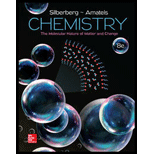
(a)
Interpretation:
The function of sulfide ions as a reducing agent on the basis of the
Concept introduction:
Redox reactions are the reactions that involve the transference of electrons. The one species gain electrons and the other one loses electrons. The reducing agent is the species that donate its electrons to the other species. It is also known as reducer or reductant. They oxidise themselves and therefore act as reducing agents.
(b)
Interpretation:
The function of sulphate ions as oxidizing agent on the basis of redox reactions is to determined.
Concept introduction:
Redox reactions are the reactions that involve the transference of electrons. The one species gain electrons and the other one loses electrons. The oxidizing agent is the species that gains electrons from the other species. It is also known as oxidizer or oxidant. They reduce themselves and therefore act as oxidizing agents.
(c)
Interpretation:
The function of sulphur dioxide as a reducing or oxidizing agent on the basis of the redox reactions is to be explained.
Concept introduction:
Redox reactions are the reactions that involve the transference of electrons. The one species gain electrons and the other one loses electrons. The reducing agent is the species that donate its electrons to the other species. It is also known as reducer or reductant. They oxidise themselves and therefore act as reducing agents. The oxidizing agent is the species that gains electrons from the other species. It is also known as oxidizer or oxidant. They reduce themselves and therefore act as oxidizing agents.
Want to see the full answer?
Check out a sample textbook solution
Chapter 8 Solutions
CONNECT ACCESS CARD FOR CHEMISTRY: MOLECULAR NATURE OF MATTER AND CHANGE
- K Draw the starting structure that would lead to the major product shown under the provided conditions. Drawing 1. NaNH2 2. PhCH2Br 4 57°F Sunny Q Searcharrow_forward7 Draw the starting alkyl bromide that would produce this alkyne under these conditions. F Drawing 1. NaNH2, A 2. H3O+ £ 4 Temps to rise Tomorrow Q Search H2arrow_forward7 Comment on the general features of the predicted (extremely simplified) ¹H- NMR spectrum of lycopene that is provided below. 00 6 57 PPM 3 2 1 0arrow_forward
 ChemistryChemistryISBN:9781305957404Author:Steven S. Zumdahl, Susan A. Zumdahl, Donald J. DeCostePublisher:Cengage Learning
ChemistryChemistryISBN:9781305957404Author:Steven S. Zumdahl, Susan A. Zumdahl, Donald J. DeCostePublisher:Cengage Learning ChemistryChemistryISBN:9781259911156Author:Raymond Chang Dr., Jason Overby ProfessorPublisher:McGraw-Hill Education
ChemistryChemistryISBN:9781259911156Author:Raymond Chang Dr., Jason Overby ProfessorPublisher:McGraw-Hill Education Principles of Instrumental AnalysisChemistryISBN:9781305577213Author:Douglas A. Skoog, F. James Holler, Stanley R. CrouchPublisher:Cengage Learning
Principles of Instrumental AnalysisChemistryISBN:9781305577213Author:Douglas A. Skoog, F. James Holler, Stanley R. CrouchPublisher:Cengage Learning Organic ChemistryChemistryISBN:9780078021558Author:Janice Gorzynski Smith Dr.Publisher:McGraw-Hill Education
Organic ChemistryChemistryISBN:9780078021558Author:Janice Gorzynski Smith Dr.Publisher:McGraw-Hill Education Chemistry: Principles and ReactionsChemistryISBN:9781305079373Author:William L. Masterton, Cecile N. HurleyPublisher:Cengage Learning
Chemistry: Principles and ReactionsChemistryISBN:9781305079373Author:William L. Masterton, Cecile N. HurleyPublisher:Cengage Learning Elementary Principles of Chemical Processes, Bind...ChemistryISBN:9781118431221Author:Richard M. Felder, Ronald W. Rousseau, Lisa G. BullardPublisher:WILEY
Elementary Principles of Chemical Processes, Bind...ChemistryISBN:9781118431221Author:Richard M. Felder, Ronald W. Rousseau, Lisa G. BullardPublisher:WILEY





